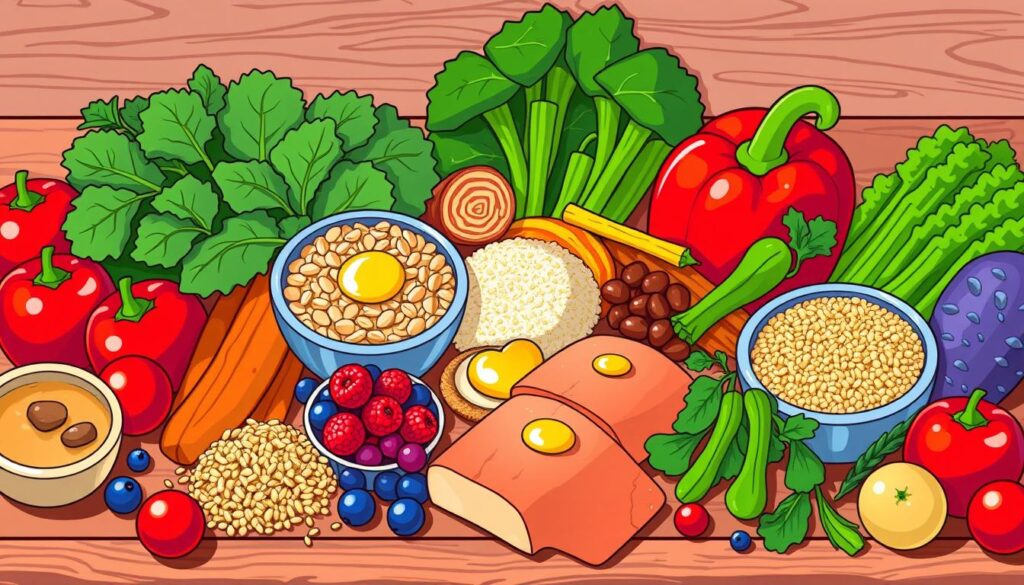Key components of a healthy heart foods diet

Did you know heart disease is the top killer worldwide, taking over 17 million lives each year? Eating right is key to fighting this global health issue. Knowing what foods are best for your heart can help protect it.
This article will dive into the heart of a healthy diet. We’ll look at foods that are good for your heart. You’ll learn about fats, grains, proteins, fruits, and veggies that keep your heart strong.
Key Takeaways
- Heart disease is a leading cause of death globally, highlighting the importance of a heart-healthy diet.
- A nutritious diet for cardiovascular wellbeing involves a balance of heart-healthy fats, whole grains, lean proteins, and antioxidant-rich produce.
- Understanding the key components of a heart-healthy diet empowers individuals to make informed choices to support a strong and resilient heart.
- Incorporating a variety of nutrient-rich foods can help reduce the risk of heart disease and promote overall cardiovascular health.
- A well-balanced heart-healthy diet is a proactive approach to safeguarding the body’s most vital organ – the heart.
Understanding the Importance of a Heart-Healthy Diet
A heart-healthy diet is key for keeping your heart in good shape. It helps lower the risk of heart disease. By choosing the right foods, you can protect your heart and stay healthy.
The Link Between Diet and Cardiovascular Health
The foods we eat affect our heart health a lot. Eating heart-healthy fats, whole grains, lean proteins, and antioxidant-rich fruits and vegetables can help. These foods lower cholesterol, control blood pressure, and cut down heart disease risk.
On the other hand, foods high in saturated and trans fats, added sugars, and processed foods are bad. They can lead to heart problems.
Preventing Heart Disease Through Nutrition
Following a heart-healthy diet is a great way to avoid heart disease. Eating nutrient-dense foods helps keep a healthy weight and improves blood flow. It also reduces inflammation, which is good for your heart.
Also, a balanced diet can help manage conditions like high blood pressure and type 2 diabetes. These conditions increase heart disease risk.
Adding a heart-healthy diet to your life is a smart move. It shows how important nutrition is for cardiovascular health. By making healthy food choices, you can live a better, longer life.
Heart-Healthy Fats: Embrace the Good Ones
Not all fats are bad for your heart. In fact, adding heart-healthy fats like unsaturated fats and omega-3 fatty acids to your diet can be very good for it.
Unsaturated fats, which include monounsaturated and polyunsaturated fats, can lower cholesterol and reduce heart disease risk. They also help control blood pressure and support heart function.
Omega-3 fatty acids, found in fatty fish, walnuts, and flaxseeds, are great for the heart. They reduce inflammation, improve blood vessel function, and lower heart attack and stroke risk.
“Incorporating heart-healthy fats into your diet is a simple yet powerful way to support cardiovascular health.”
To enjoy the benefits of heart-healthy fats, try these tips:
- Swap saturated and trans fats for unsaturated fats from avocados, olive oil, and nuts.
- Add omega-3 fatty acids by eating fatty fish like salmon, tuna, and mackerel regularly.
- Choose plant-based heart-healthy fats from nuts, seeds, and vegetable oils.
By choosing heart-healthy fats, you can help keep your heart healthy and lower your risk of heart disease.
- Winter skincare routine tips
- Why We Need Vitamin D
- What to Do After a Bad Night’s Sleep
- What Is Whooping Cough?
- what is nightfall and solutions in psychology
- What Are The Key Components of a Healthy Heart Foods Diet
- Understanding Health Equity: A Comprehensive Guide
- Types of mental health issues and illnesses
- Things You Should Never Say to Your Partner
- The mental health revolution: breaking down Stigmas
Whole Grains: A Powerhouse of Fiber and Nutrients
Whole grains are key to a heart-healthy diet. They are full of soluble fiber, vitamins, and minerals. These nutrients work together to support heart health. Adding whole grains to your meals can make a big difference in your heart’s health.
Choosing the Right Whole Grains
Not all whole grains are the same. Look for products where whole grain is the first ingredient. This means whole wheat, brown rice, or quinoa. Stay away from refined or processed grains that lack nutrients. Choose a variety of whole grains like:
- Whole wheat
- Brown rice
- Oats
- Barley
- Quinoa
- Bulgur
- Millet
Incorporating Whole Grains into Your Diet
Adding whole grains to your diet is simple. Swap refined grains for whole grains in your favorite dishes. Use whole wheat bread or pasta instead of white. You can also add them to soups, stews, and salads, or serve them as a side dish.
| Whole Grain | Fiber Content (per 1 cup serving) | Nutritional Benefits |
|---|---|---|
| Whole Wheat | 4.5 grams | Rich in B vitamins, magnesium, and selenium |
| Brown Rice | 3.5 grams | Provides manganese, phosphorus, and antioxidants |
| Oats | 4 grams | High in soluble fiber, which helps lower cholesterol |
By making whole grains a regular part of your diet, you nourish your body. You get a lot of fiber, vitamins, and minerals. These help make your heart system stronger and healthier.
“Whole grains are the foundation of a nutritious, well-balanced diet that promotes heart health. They provide a steady stream of complex carbohydrates, keeping you feeling full and satisfied.”
Lean Proteins: Building Blocks for a Strong Heart
Lean proteins are key for a heart-healthy diet. They help grow and repair muscles and boost heart health. You can choose from lean animal proteins or plant-based options. Both are great for your heart.
Lean meats like chicken, turkey, and some beef and pork are good for your heart. They have less fat and cholesterol than fattier meats. Seafood, especially fatty fish like salmon, tuna, and mackerel, are also great. They have omega-3 fatty acids that help lower blood pressure and heart disease risk.
Plant-based proteins are also good for your heart. Legumes like beans, lentils, and chickpeas are full of fiber, minerals, and antioxidants. Tofu and tempeh are also lean, plant-based proteins that can be added to many dishes.
It doesn’t matter if you choose animal or plant-based proteins. Just pick lean, unprocessed options and eat them as part of a balanced diet. Eating lean proteins regularly can help keep your heart strong and healthy.
“Lean proteins are the building blocks of a heart-healthy diet, providing essential nutrients while supporting cardiovascular well-being.”
Antioxidant-Rich Fruits and Vegetables: Nature’s Superfoods
Fruits and vegetables are full of vitamins, minerals, and antioxidants. They are great for heart health. These colorful foods have phytochemicals that fight inflammation, lower cholesterol, and protect the heart.
Colorful Produce and Their Benefits
Each color in the produce rainbow has its own health benefits. Blueberries, for example, are full of anthocyanins. These help improve blood vessel function and lower heart disease risk.
Leafy greens like spinach and kale are also good. They have nitrates that can lower blood pressure and improve blood flow.
Eating a variety of antioxidant-rich foods, like fruits and vegetables, is key to a heart-healthy diet. Adding these foods to your meals and snacks can help keep your heart strong.
FAQ
What are the key components of a heart-healthy diet?
A heart-healthy diet includes several key elements. It has heart-healthy fats like unsaturated fats and omega-3s. It also includes whole grains, which are rich in fiber and nutrients.
Lean proteins, from animals or plants, are also important. Antioxidant-rich fruits and vegetables are crucial. Lastly, it’s good to choose low-sodium options and foods high in fiber.
How do heart-healthy fats benefit cardiovascular health?
Heart-healthy fats, like unsaturated fats and omega-3s, are great for your heart. They help lower cholesterol and reduce inflammation. These fats are found in foods like avocados, nuts, seeds, and fatty fish.
What are the benefits of incorporating whole grains into a heart-healthy diet?
Whole grains are packed with fiber, vitamins, and minerals. They help lower cholesterol and regulate blood sugar. They also make you feel full, which helps with weight management.
Examples of whole grains include brown rice, quinoa, oats, and whole wheat.
How can lean proteins contribute to a heart-healthy diet?
Lean proteins are essential for a heart-healthy diet. They come from animals or plants and are low in saturated fat and cholesterol. Examples include grilled chicken, fish, legumes, and tofu.
What are the benefits of incorporating antioxidant-rich fruits and vegetables into a heart-healthy diet?
Fruits and vegetables high in antioxidants protect the heart and blood vessels. They are also rich in fiber, vitamins, and minerals. Examples include berries, leafy greens, and citrus fruits.
How can low-sodium options and fiber-rich foods contribute to a heart-healthy diet?
Choosing low-sodium foods and fiber-rich foods is key. They help regulate blood pressure and cholesterol levels. This reduces the risk of heart disease.
These choices also help maintain a healthy weight. A healthy weight is crucial for heart health.


